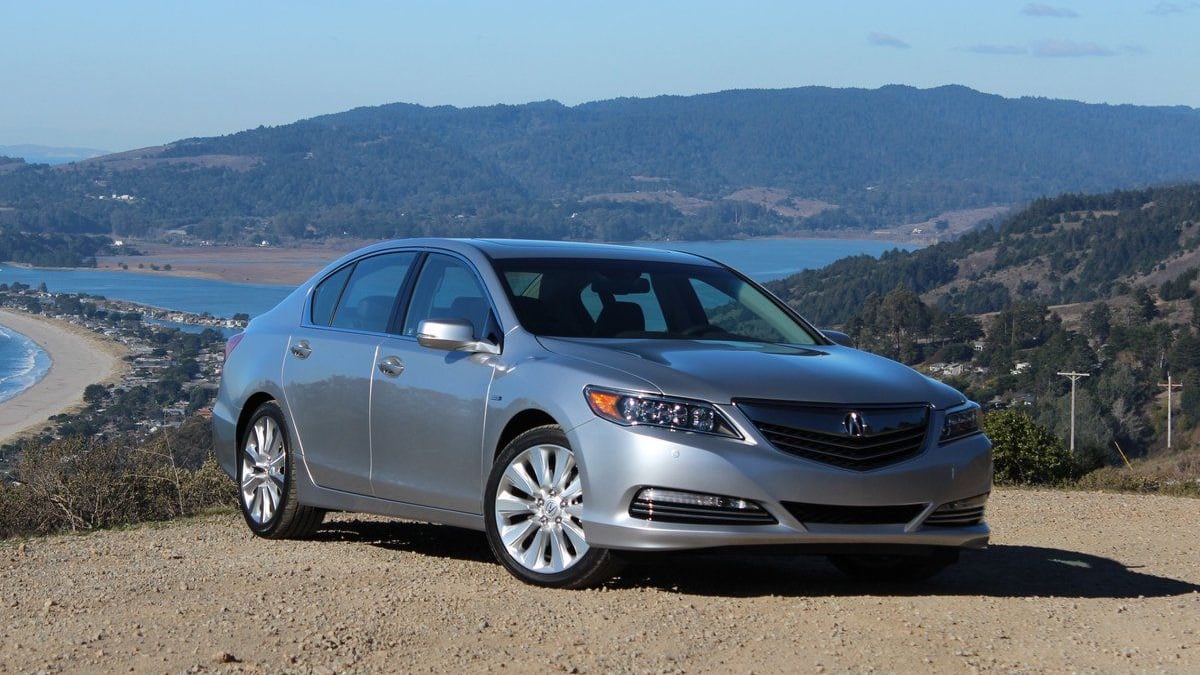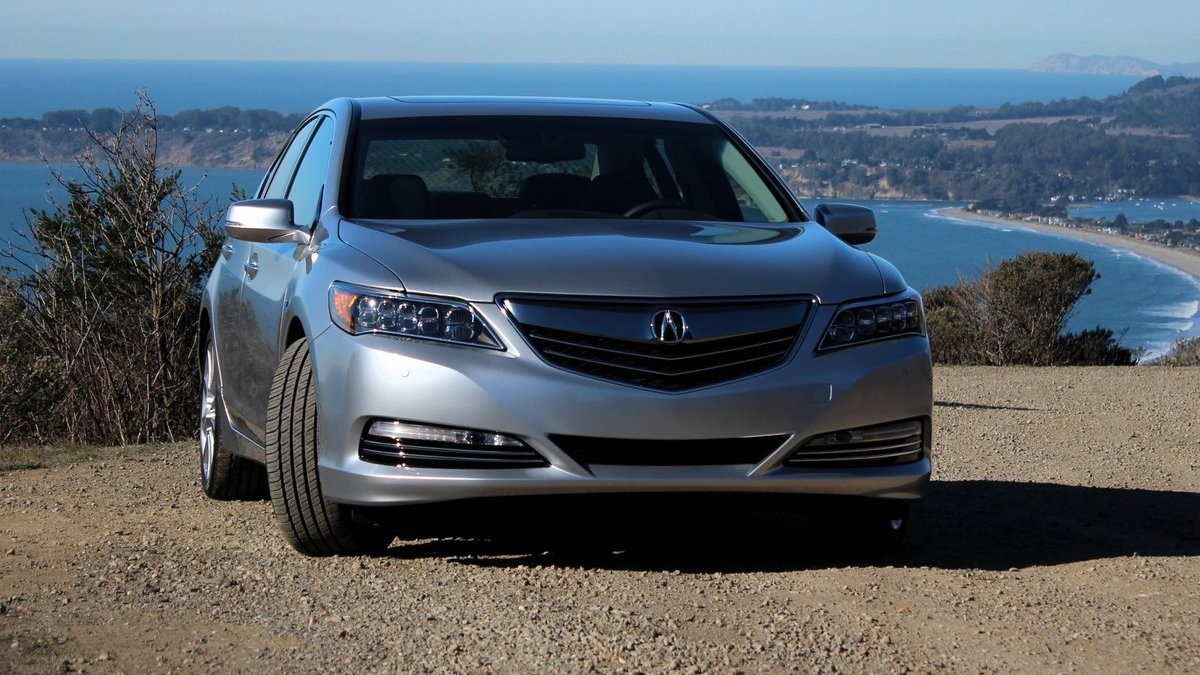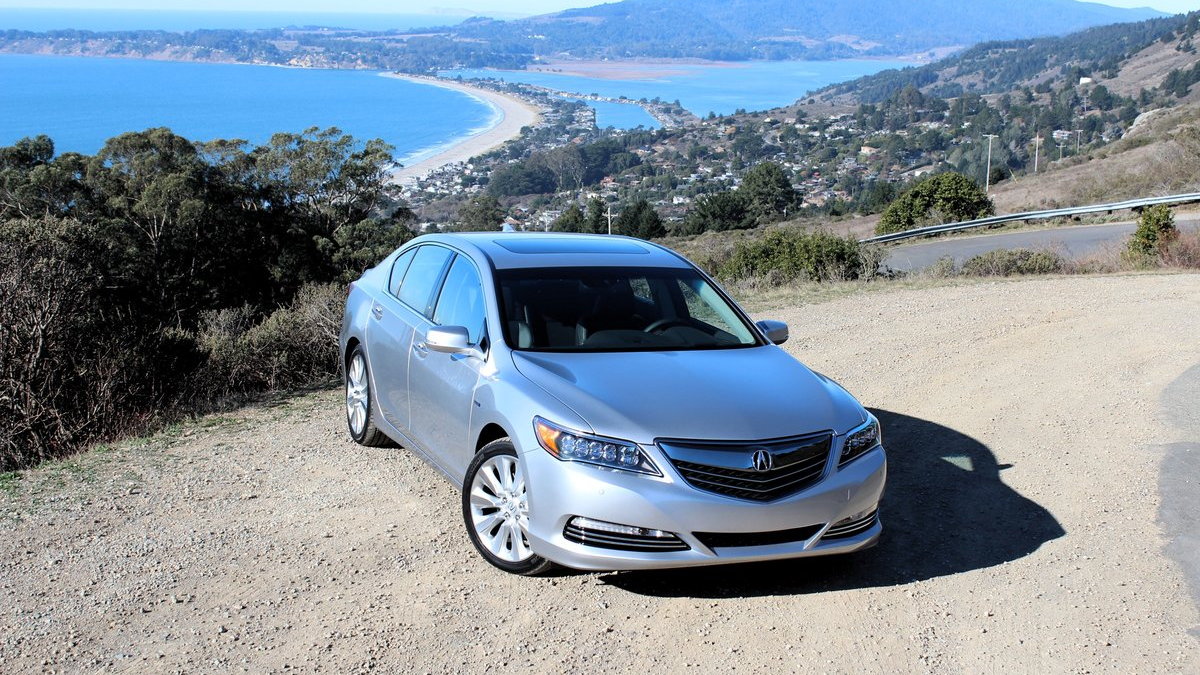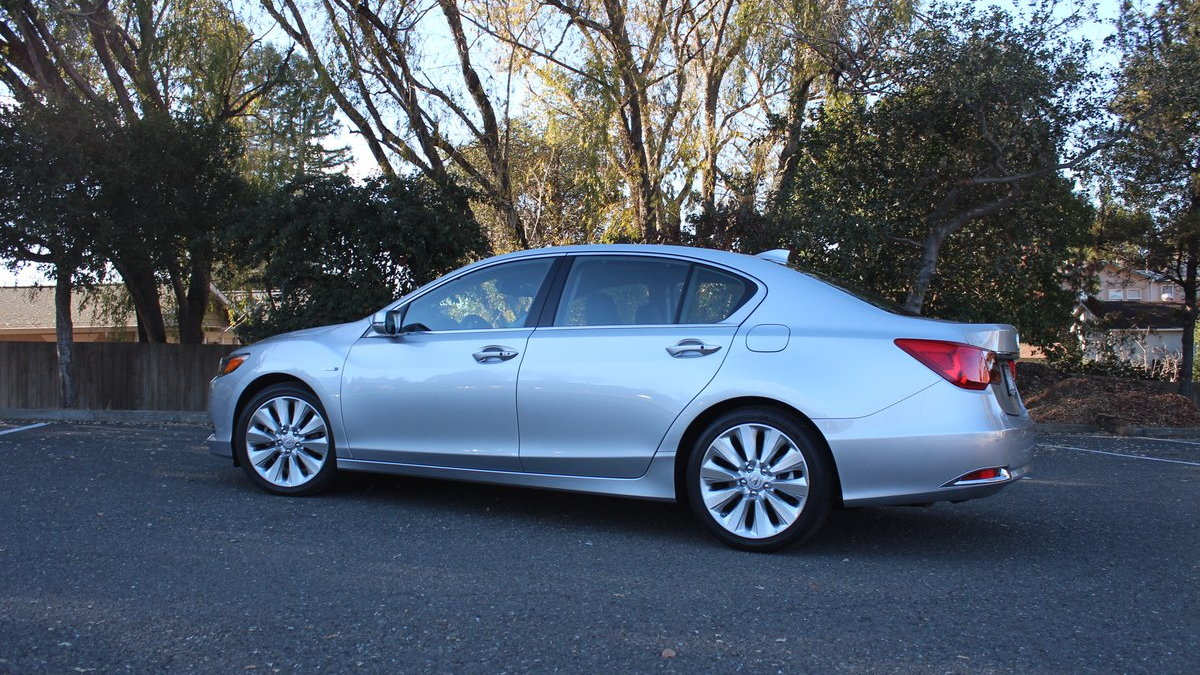The 2014 Acura RLX Sport Hybrid offers all-weather traction and V-8-like performance, with the fuel-efficiency of a four-cylinder.
That's one way to sum up this tech-loaded luxury flagship, which will begin reaching Acura dealerships next spring. But after spending a few hours driving it, we can attest that's not this model's raison d'être.
What is that? To put it as simply as possible, the Sport Hybrid has fantastic handling. And it's the technology behind why it handles so phenomenally well that separates it from any other luxury hybrid—and any other sport sedan, really.
Like an overly modest Olympic athlete, the RLX Sport Hybrid doesn't freely flaunt its talents. Ease your speed up in a series of tight switchbacks, as we did, and you simply work up to a disconcerting shriek of the tires, as the front wheels plow and this big sedan understeers slightly.
It would be quite the shame if we had simply left our introduction to the RLX Sport Hybrid right there, and written this off as a quick but hardly athletic luxury sedan. But we'd gotten a taste of what this special hybrid all-wheel-drive system could do out on the track in Japan last year, so we pushed on for that.
Instead, drive it like you stole it, as they say, and what you think was a ragged edge wasn’t that at all; using what feels like physics-defying magic at the rear wheels, the RLX reads that as a sign to send power selectively to each of the rear wheels—the outside rear wheel especially—nudging your trajectory back right where it should be.
It's rather unsettling at first, because you feel that nudge from the driver's seat, but not through the steering wheel. But the novelty doesn't wear off. We can see the RLX's attributes being just as useful on a weather-slicked highway, making an emergency maneuver, as we can on the mostly empty backroads where we test-drove the RLX.
Nudges you back on course, doesn't scrub off speed
No, the system won't make the RLX feel like a rear-wheel-drive sport sedan, but that's not the intent; instead, it nearly instantly banishes all the understeer, and makes it neutral. You don't slow down; tires aren't howling; stability control isn't buzzing; it merely works its magic and you barrel through, dynamically confident and still at full boil.
At those moments it feels like the system is doing more than keeping you stay on track; it's actually nudging you faster. And it's fast. We'd venture to say that, by power to weight (even though the Hybrid is about 350 pounds heavier than the standard RLX, at just over 4,000 lb.), it's one of the fastest sedans through the curves, at any price.
Acura's so-called Super Handling All Wheel Drive system was already one of the best on the market—because it can essentially steer with its rear wheels, sending more power to the outer rear wheel in a corner. Now it's effectively taken that system a step further with strong electric motors at the rear wheels; between the rear wheels, one can deliver forward torque while the other can counter it by smartly engaging regenerative braking at the same time.
First, we should give you a little background on how Acura pulls all this off. Under the hood, there's a version of Acura's 3.5-liter V-6, with i-VTEC variable valve timing plus VCM (variable cylinder management). It's hooked up to a new seven-speed dual-clutch automated manual gearbox with integral electric motor. That motor system makes 35 kilowatts and 109 lb-ft and serves not only as motivation for the sedan in low-speed and lower-load conditions but a way of filling in the gaps between gears and smoothing shifts.
But that's only part of it. Mounted at the rear subframe is a so-called Twin Motor Unit that includes two 27-kW, 54-lb-ft electric motors, with a clutch in between. That allows torque from both motors to be sent to one of the sides in some situations, or for one motor to be boosting and twisting forward while the other is resisting and recovering energy through regenerative braking.
Altogether, while the V-6 makes 310 horsepower and 273 lb-ft of torque, the Sport Hybrid system makes 377 hp and 377 lb-ft.
With sophisticated electric controls that can recognize the difference between performance driving and slippery conditions, Acura allows seven different drive modes, including moving using the rear motors only on gentle launches and lower-speed cruising, using combinations of the engine and front motor in higher-speed cruising and moderate acceleration, and using all four wheels during aggressive acceleration. Likewise, there's a traditional AWD mode that allows a little slip for snowy driveways.
So smooth, the way it blends power sources
While you might hear the V-6 chime in as you're accelerating, it'll be hard to distinguish exactly when it started back up. The RLX Sport Hybrid has one of the smoothest engine restarts we've found in any hybrid—thanks in part to a motor-controlled active engine mount system, and to a special vibration-quelling strategy that closes the intake valves momentarily on startup. There's also active noise cancellation inside, which helps keep the cabin quiet and free of unwanted boom and whine. Sound-insulating glass and a special noise-reducing wheel design pitch in as well.
A battery pack—actually, a so-called Intelligent Power Unit, with 72 lithium-ion cells for 1.3 kWh and 260 volts—is located at the far front of the trunk, just behind the rear seatback. That eliminates the possibility of folding seatbacks—or even a pass-through—but it doesn't interfere with rear-seat space, and it still leaves the trunk space of a generously sized compact sedan or smaller mid-sizer.
The RLX Sport Hybrid interior has all the comfort and space of its front-wheel-drive sibling—already a package that offers more space in back especially (best in class, they say) compared to any of the German luxury sedans close to its size. Ride quality is also great, thanks to Amplitude Reactive Dampers that allow that sharp handling response while soaking up minor imperfections.
Inside, the cabin appointments and interface are virtually the same as for its front-wheel-drive counterpart; but the RLX Sport Hybrid is also the first Acura model to get a new electronic gear selector, located on the left side of the center console and just beside your right knee. And the head-up display that's offered here is a step up from most, allowing a customizable display that even allows you to keep abreast of the torque vectoring, wheel by wheel.
One other interesting piece of technology in the RLX Sport Hybrid is the so-called Reactive Force Pedal, with which the accelerator can not only allow different levels of sensitivity but also feel like it's sprung more heavily or lightly. While Sport Mode turns that (and Active Cylinder Management) off—instead allowing a traditional, more linear feel—in other situations it will push back with more force to help you get better fuel economy, or when any of the RLX's many active-safety systems sense danger.
Like an electric car, with the soundtrack of a gasoline sport sedan
Altogether, in either of the modes (there are just two here, regular and sport), the powertrain feels perky and responsive, however, and when you put your right foot into it the RLX gathers velocity with the steadiness and near-instantaneous response of an electric car. You hear the dual-clutch gearbox knocking off shifts and changing the tone of the engine's intake note, but you don't feel the shifts—just a smooth, uninterrupted rush of power. And quick stabs of the accelerator bring out quick coordination between the electrics and the gearbox to make sure you don't miss a beat.
Over in Sport mode, the transmission always felt half a beat ahead of us, downshifting a gear or two the moment we lifted and dabbed the brakes—and making us feel like we'd use the steering-wheel paddle-shifters a lot less here than in most other sport sedans.
While we were left wanting for steering feel—it centers nicely, but there's really none here, and the ratio feels too long—the RLX Sport Hybrid has one of the most confidence-inspiring brake-pedal behaviors we've ever experienced in a hybrid model. It's not quite up to non-hybrid standards, but quite easy to precisely stop exactly where you want.
The down side of this system is that it doesn't reward finesse. You need to push the car dynamically to really feel the benefits of the system, as it's effective but completely unobtrusive otherwise. If we have one complaint about the system, it’s the obvious: It makes it so easy to push the limits and drive irresponsibly that it removes some of the learning. And some of the fun.
The up side, of course, is that it recasts the hybrid system as a true asset to performance driving—not a hindrance to it.
The other big benefit, of course, is fuel efficiency. Acura emphasizes that performance is the priority with the RLX Hybrid; yet if you drive it very gently, you could do surprisingly well on a gallon of gas. EPA ratings stand at 28 mpg city, 32 highway (30 Combined). Our observed 22 mpg over two different driving loops—mostly enthusiastic driving on back roads—didn't show anything close to that, but we're eager to see what the RLX Sport Hybrid will do in everyday driving.
Acura sees the RLX Sport Hybrid's competition including the Lexus GS450h, the BMW ActiveHybrid 5, and the Mercedes-Benz E400 Hybrid—as well as the Audi A6 3.0T. We had access to an A6 3.0T and a GS450h on the drive, and found that while the A6 was more 'intuitive' in the corners at first go, the RLX was unquestionably quicker—and frustrating power-delivery delays sapped any fun from the GS Hybrid, compared to the others.
Underwhelming in some ways—but performance isn't one of them
Based on our drive, the RLX Sport Hybrid underwhelms at first, but then overdelivers in a spirited drive. It's a car that will confound you in its presentation (its conservative interior and frustrating infotainment interface are still low points) yet wow you when it's pushed to perform—and quite possibly prove you wrong.
The powertrain of the Sport Hybrid, by the way, provides a special preview of what's going to be installed in the upcoming Acura NSX—only with the gasoline engine powering the rear wheels there, the motor system in front, and a lot more power per pound, of course.
If your reaction after a fast, enthusiastic drive in one is anything like ours, you'll probably find that it takes your preconceptions of what a hybrid should be, and of what a sport sedan should be, and shakes them up.
That's a very positive trajectory for Acura, and a great sign for the NSX.
_______________________________________






